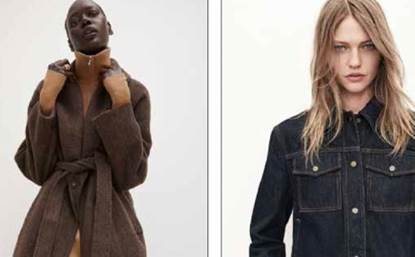Sustainability is no longer an option for fashion and retail brands. More than a trending buzzword, it needs to be woven into the very fabric that’s used to make our apparel.
For a brand to be sustainable, it needs to look beyond its profit, placing value on its environmental and social impact. So, it’s no wonder that fashion and retail brands are making sustainable sourcing an essential part of their business model.
Sustainable sourcing involves the consideration of social, ethical and environmental factors when choosing a supplier. Essentially, a brand needs to assess the treatment of the workers involved in its supply chain and the environmental impacts of the materials that are used. With the growth of conscious consumerism, fashion brands are being held accountable for their environmental and social impact. 88 per cent of consumers1 mention that they want brands to help them be more environmentally friendly, however, in 2019 only 1 per cent of new products2 from mass-market apparel companies were tagged. Global demands are shifting, and if brands want to succeed in a competitive market, they need to adapt and respond to the evolving mindset of the consumer.
Millennials and Generation Z3 consumers are driving the trend of conscious consumerism and retail brands are adapting with 56 per cent of fashion apparel COP’s4 agreeing that sustainable sourcing is a key strategic part of doing business. Apparel companies further reported that their top ranked priority was sourcing5 sustainable materials, followed by transparency and traceability, supplier relationships, and purchasing practices.

This growing trend of fashion and retail brands sustainably sourcing their materials pushes companies to move away from the harsh exploitative methods that have allowed them to make mass quantities of clothes at a low cost. Driven by fast fashion, these exploitative methods are responsible for an incomprehensible amount of waste, pollution and exploitation. Shockingly, fast fashion has seen the growth of 2 seasons, to 52 micro-seasons6, continuing down the path of endless production to mindless consumption. The growth of fast fashion has allowed companies to seek out ways to mass-produce at a low cost, and globalisation helped to enable this. Developed countries have sourced suppliers from developing countries, and through the nature of eco-colonialism, western countries have been able to abuse their power by pushing wages down and speeding production up.
An example of this is in Bangladesh, where workers7 are working 10 hours a day, earning $68 a month. Additionally, in Dhaka, Bangladesh’s capital, effluent runoff from surrounding garment factories has resulted in 3 rivers being declared” biologically dead”8, where no living thing can survive in the water. It was only a matter of time until the world grew tired of the immoral and environmentally destructive impacts of the fashion industry, and consumers are asking fashion brands to set trends, not just for our wardrobes, but also for people and the planet.
When talking about companies that have been setting the trends for sustainable sourcing, one has to acknowledge Patagonia. Having prioritised both the planet and people for years, they are pioneers for sustainable fashion; since 1985, they have pledged 1 per cent of their sales to protect the environment. They use recycled materials, ensure that their workforce is treated fairly, and support animal welfare organisations. They are constantly looking for ways that they can minimise their environmental impact and offer transparency throughout. If brands want inspiration on how to sustainably source their products, then Patagonia is not one to forget.
More recently, H&M and Zara, the two largest fashion retailers in the world, have acknowledged the market demand for more sustainable fashion models. H&M has launched their Conscious Collection where their products are ethically sourced, made from sustainable or organic materials. They want to ensure that they take into consideration all social and environmental impacts throughout the entire sourcing process.
Zara, similarly to H&M, has also launched their Join Life9 range, selling clothes derived from recycled and ecologically grown cotton. They are moving towards integrating social and environmental sustainability throughout their products, trying to minimise the impact of their products. They are also working to promote human rights and worker empowerment by working closely with their trade unions, international bodies and suppliers.
It is great to see both Zara and H&M making the change towards sustainability. As the largest global retailers, they are major contributors to the fashion industry’s 10 per cent global greenhouse gas emissions10 output. Therefore, it is important to see industry leaders joining the movement and making a change towards a more sustainable world.
REFERENCES:
1.https://www.forbes.com/sites/solitairetownsend/2018/11/21/consumers-want-you-to-help-them-make-a-difference/?sh=512896e86954
2,4,5. https://www.mckinsey.com/~/media/mckinsey/industries/retail/our%20insights/fashions%20new%20must%20have%20sustainable%20sourcing%20at%20scale/fashionsnew-
must-have-sustainable-sourcing-at-scale-vf.pdf
3. https://www.mckinsey.com/industries/retail/our-insights/the-influence-of-woke-consumers-on-fashion
6. https://medium.com/@andreaazevedo_32670/the-effects-of-the-52-micro-seasons-on-the-environment-edd87951b74f
7. https://www.pri.org/file/2019-05-09/garment-workers-bangladesh-work-average-10-hours-day-often-they-are-forced-work
8. https://www.iamrenew.com/environment/bangladeshs-polluted-waters-rivers-dying-due-to-dyeing
9. https://www.zara.com/uk/en/z-join-life-mkt1399.html?v1=1902922
10. https://unece.org/forestry/press/un-alliance-aims-put-fashion-path-sustainability
This article was first published in the September 2021 edition of the print magazine.










Comments